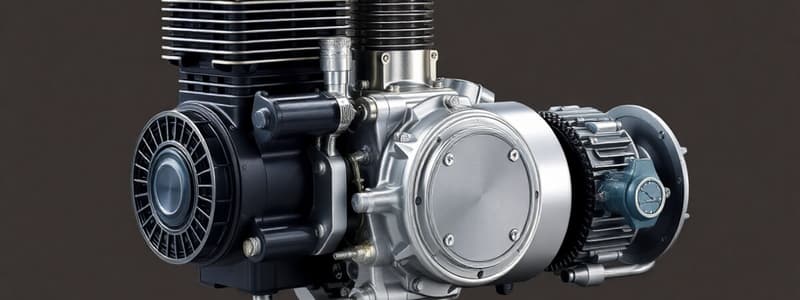Podcast
Questions and Answers
A two-stroke engine requires a separate oil lubrication system.
A two-stroke engine requires a separate oil lubrication system.
False (B)
Four-stroke engines complete one power cycle in four strokes of the piston.
Four-stroke engines complete one power cycle in four strokes of the piston.
True (A)
Two-stroke engines are typically heavier and more complex than four-stroke engines.
Two-stroke engines are typically heavier and more complex than four-stroke engines.
False (B)
Four-stroke engines are known for their higher power output compared to size.
Four-stroke engines are known for their higher power output compared to size.
Both two-stroke and four-stroke engines can be air-cooled or liquid-cooled.
Both two-stroke and four-stroke engines can be air-cooled or liquid-cooled.
Study Notes
Engine Design Differences
Two-Stroke Engine
- Cycle Completion: Completes one power cycle in two strokes of the piston (one crankshaft revolution).
- Piston Movement: Piston moves up and down, creating intake and exhaust in the same cycle.
- Fuel Mixture: Requires a mix of fuel and oil for lubrication; often uses pre-mixed fuel.
- Ports: Utilizes ports for intake and exhaust rather than valves; simpler design.
- Power Output: Produces a power stroke with every revolution, leading to higher power output relative to size.
- Weight and Size: Generally lighter and more compact than four-stroke engines.
- Cooling: Often air-cooled, reducing complexity and weight.
Four-Stroke Engine
- Cycle Completion: Completes one power cycle in four strokes of the piston (two crankshaft revolutions).
- Piston Movements: Involves four strokes: intake, compression, power, and exhaust.
- Valves: Uses intake and exhaust valves controlled by a camshaft; more complex design.
- Lubrication: Uses a separate oil lubrication system, leading to better lubrication efficiency.
- Fuel Consumption: Generally more fuel-efficient than two-stroke engines due to complete combustion.
- Power Output: Produces a power stroke every two revolutions, resulting in lower power output compared to size.
- Cooling: Can be air-cooled or liquid-cooled, allowing for better thermal management.
- Applications: Commonly found in automobiles, generators, and larger machinery due to efficiency and longevity.
Two-Stroke Engine
- Completes a power cycle in two strokes of the piston, equating to one crankshaft revolution.
- Piston performs intake and exhaust functions within the same cycle, enhancing efficiency.
- Requires a fuel and oil mixture for lubrication, often utilizing pre-mixed fuel.
- Employs ports instead of valves for intake and exhaust, contributing to a simpler structure.
- Produces a power stroke with every crankshaft revolution, increasing power output relative to size.
- Generally lighter and more compact, making it suitable for applications where weight is crucial.
- Frequently designed as air-cooled, which simplifies construction and reduces weight.
Four-Stroke Engine
- Completes a power cycle over four strokes of the piston, which correlates to two crankshaft revolutions.
- Involves four distinct actions: intake, compression, power, and exhaust, promoting comprehensive fuel use.
- Utilizes intake and exhaust valves operated by a camshaft, resulting in a more intricate design.
- Features a dedicated oil lubrication system, improving efficiency and effectiveness in lubrication.
- Typically more fuel-efficient, allowing for better utilization of fuel through complete combustion.
- Produces a power stroke every two revolutions, leading to comparatively lower power output based on size.
- Can implement either air cooling or liquid cooling, aiding in effective thermal management.
- Commonly used in automobiles, generators, and larger machinery due to durability and efficiency.
Studying That Suits You
Use AI to generate personalized quizzes and flashcards to suit your learning preferences.
Description
Test your knowledge on the differences between two-stroke and four-stroke engines. This quiz covers key aspects such as cycle completion, piston movement, fuel mixture, and power output. Understand the unique characteristics and applications of each engine type.




